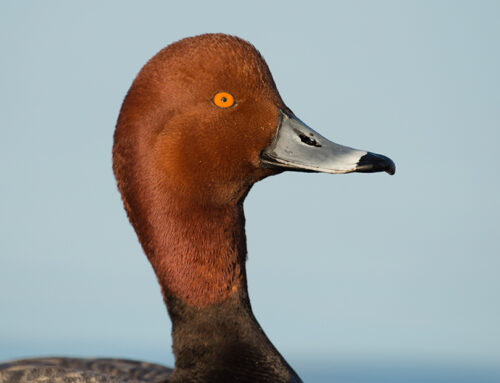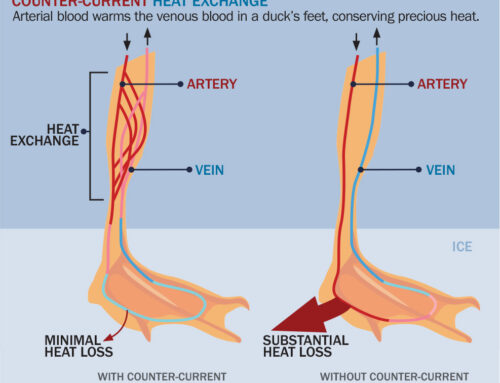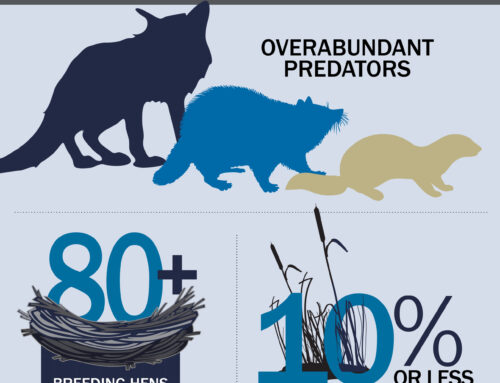Unusual Nesters
Some birds go to wild lengths to hatch their eggs

Later this spring, somewhere in the deserts of western Nevada, common merganser ducklings will descend from their nests. They’re categorized as cavity nesters, yet it’s not the usual tree from which these mergies will make their leaps. Like many ducks in North America’s Great Basin, they will have nested in a craggy rock—more specifically, a fracture in the rock that provides protection from ground predators and weather.
From these cliff-hanging mergansers to the odd mallard nesting in a flower planter or landscape shrubbery, waterfowl can find creative strategies outside their usual nesting habits to give their broods the best chance at survival. Here are some of the more clever, interesting, and downright wild strategies used by nesting ducks.
Risk and Reward
Waterfowl species can generally be separated into three categories of nesters: upland, overwater, and cavity nesters. The amount of energy it takes to successfully raise their young is considerable, particularly when taking into account the ever-increasing threat of nest predation. In fact, Delta’s research shows that 90% of failed duck nests in the prairie pothole region are lost to predators.
Many strategies nesting waterfowl employ are designed to avoid this risk.
“There is an interesting case regarding red-breasted geese in northern Russia,” said Dr. Chris Nicolai, waterfowl scientist for Delta Waterfowl. “Every year, many of them will be found nesting near a gyrfalcon. The gyrfalcon will begin nesting and suddenly, there could be 200 pairs of red-breasted geese within 100 feet of it. The falcon is going to rip up anything that comes in looking for eggs, and it doesn’t eat eggs itself, so it serves as a form of protection.”
A similar phenomenon has been reported with common eiders along coastal Alaska.
“They are nesting in dense gull colonies,” Nicolai explained. “They’re nesting right near their predators, but as long as you stay on your eggs to keep them safe, a big gull is worth its weight when a fox or other predator comes in search of a meal. And eiders are particularly known for not leaving their nest often during incubation.”
It feels counterintuitive at first glance, but these eiders and red-breasted geese have learned that staying within reach of specific predators can actually negate predation costs to their nests.
Nest Parasitism
Raising a brood is no easy task and, according to some studies, it seems some waterfowl are simply not up to the assignment. Nest parasitism—a strategy in which waterfowl (and other species of birds) lay their eggs in the nest of another duck or goose—can be rampant among particular species of waterfowl, more often when ducks are forced to nest in close quarters and higher densities.
“Nest parasitism is a transfer of the energy cost and responsibility of raising their brood to another duck, where she will incubate and raise it as her own,” said Nicolai. “Wood ducks, hooded mergansers, and redheads are horrible parasites. You can even get geese laying in eider nests, and eiders laying in goose nests.”
Ducks can lay more than one parasitic egg in a nest, but because they only lay one egg per day, the act of depositing multiple parasitic eggs can be a calculated challenge.

“There are some occasions where waterfowl will even fight over the real-estate of the nest. But in most cases, the sneaky parasite duck knows what it’s doing,” said Nicolai. “It is likely to hide, waiting for the nesting hen to leave. Once she vacates her nest to take a break, the parasitic hen moves in quickly to lay her egg so she can get out of the area before confrontation occurs.”
Nest parasitism can be categorized in two ways: interspecific and intraspecific. Interspecific parasitism takes places between two different species: For example, an eider and a goose or a wood duck and hooded merganser. Intraspecific takes place between waterfowl of the same species, which—due to lack of differentiators in the egg’s appearance—can make identifying the act of parasitism particularly difficult for biologists.
Cavities and Cliffs
Dr. Nicolai spent much of his graduate work in the western regions of the United States, particularly Nevada, where he witnessed cavity-nesting ducks turn to cliff-dwelling habits firsthand.
“I’ve seen this in the desert, for example, when I lived in Reno. The Truckee River runs 120 miles, gets fed by Lake Tahoe, and continues to the unique desert lake of Pyramid Lake. At the top of the Truckee, there are abundant ponderosa pines, sugar pines, and other trees to provide natural cavities, but as you move down the river, all trees disappear and common mergansers have few tree cavities to use,” Nicolai said. “It is the same cavity-nesting bird, but out in the desert without a tree in sight, they nest in little cracks in the rock tufa formations instead of holes in ponderosa pine trees. It’s a similar concept but an interesting one.”
Nicolai believes the strategy is happening throughout the West’s Great Basin, noting that geese are even more commonly known to be found cliffside.
“Moffitt’s Canada geese, one of the seven subspecies, deal with a lot of ground predators,” said Nicolai. “So, they’ll move their nest up into old raptor nests in an old cottonwood tree, or they’ll get onto a little edge of a cliff to get away.”
According to Nicolai, similar resourcefulness is also seen in cooler climates, such as the Arctic nesting habits of some Taverner’s cackling geese. He suspects that those seeking higher ground are doing so in response to an increase in Arctic fox populations.
Malleable Mallards
But mallards are the queens of adaptable, resourceful nesting.
“Our Delta Hen Houses are another great example of unusual nesting,” said Nicolai. “It is pretty incredible to think we have figured out how to get a duck to nest on rolled wire atop a pole, but it is incredibly effective.”
In fact, a mallard using a Delta Hen House is up to 12 times more likely to hatch its nest successfully than a mallard nesting in nearby upland grass cover. Additionally, Delta can place Hen Houses in areas where agriculture has eliminated the upland grass cover.
And while mallards are by far the most likely species to use a Delta Hen House, redheads, wood ducks, and common goldeneyes (to name a few) have all been known to call one home. Incredibly, Delta has even received reports of mallards attempting to nest in Hen Houses while they’re still stacked up, awaiting delivery to their destinations.
Changing With the Times
With the waterfowl breeding landscape continually evolving, waterfowl are being forced into greater densities and into behaviors they don’t show in areas of normal pair densities. With that, their instincts inspire them to adapt to survive and, in turn it seems, the birds are getting increasingly creative when it comes time to nest.
“Our changing landscape has driven waterfowl of all species to nest in greater densities, and a higher rate of predation is a price they pay,” Nicolai said. “But they’re wonderful innovators, so it’s no surprise they have gotten creative to get away from the crowds.”
Christy Sweigart of Elizabeth, Colorado, is a staff writer for Delta Waterfowl.






Leave A Comment